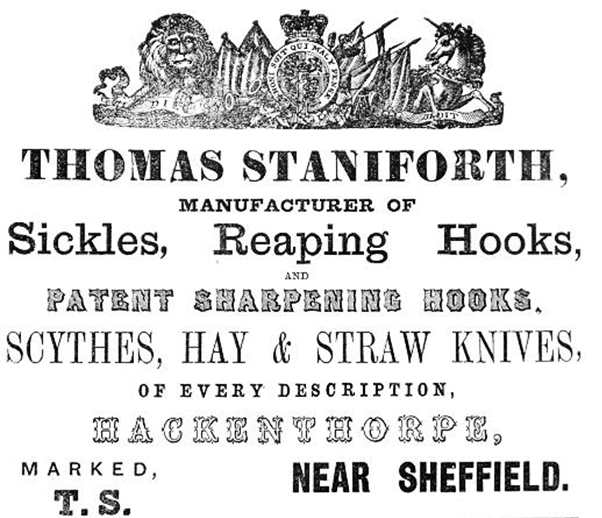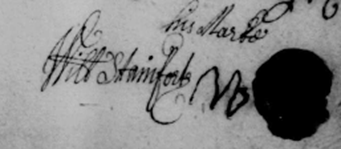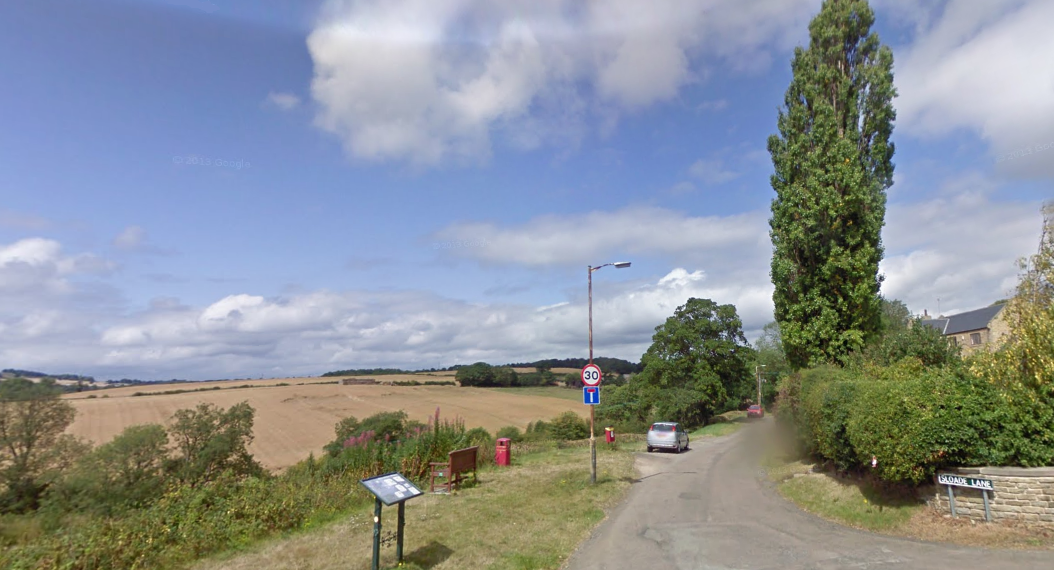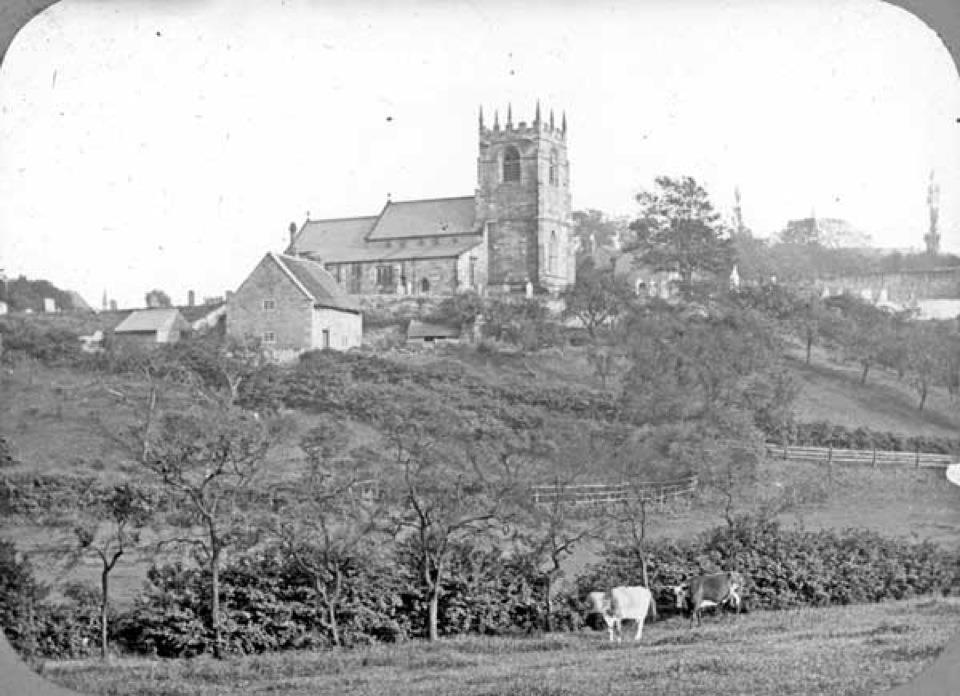
Thomas Staniforth & Co. Sickle works at Hackenthorpe.
 William Staniforth's mark on his own will dated 1696.
William Staniforth's mark on his own will dated 1696.
William is apprenticed to his grandfather as a sicklesmith in 1654, and on the record his father William is described as being ‘Of Sloade Lane’ in Ridgeway, the same road Litfield Farm stands where his father William Staniforth of Litfield resided. Litfield farm would have passed to his brother John Staniforth by this time.
Richard Hodgson, William’s grandfather passed away in 1663, and following this William marries a woman named Lydia. It is unclear exactly what her maiden name was, and many researchers have tried to figure out this mystery, we only see his wife Lydia mentioned on various documents. The marriage took place the year after William took his freedom from his grandfather. We also see William taking on his own apprentice this same years, another William Staniforth, son of Thomas Staniforth of Carter Hall, which stands a mile to the north of Sloade Lane.
This apprentice record is interesting as William is described as being ‘Of Jordanthorpe’ which suggests William likely resided with his grandmother upon the death of his grandfather Richard Hodgson. Perhaps William felt he owed his grandmother due to her raising him from an early age.
William and Lydia’s first child Elizabeth was baptized at Norton on the 18th October 1664, on this record William and Lydia are again described ‘Of Jordanthorpe’. By the time of the second daughter Lydia’s baptism, he is residing in Eckington parish. Lydia is baptised on the 16th February 1666.
 Sloade Lane in 2011.
Sloade Lane in 2011.
Rebecca Staniforth, William and Lydia’s third daughter was baptised on the 23rd September 1668 at St. Mary’s Church, Beighton. St. Mary’s was the parish church for both Hackenthorpe and Beighton villages. His next two children appear to be twins, a daughter Sarah and a son William both baptised on the 16th February 1671. Sarah would only survive two days, and William three weeks. Although it is unclear as to why the twins died, child mortality at that time was high, and it was not uncommon for couples to lose children so young. It must however have been devastating to them to lose twins. This is evident, as the couple waited five years following the twins death before their last, and only surviving son Samuel is baptised on the 2nd February 1679.
Another useful record we have from this time period is the Hearth Tax from 1662, brought in by Charles II. William first appears in 1670 and by 1672 he was paying tax on ‘smithy hearth’. William later appears leasing part of a messuage of land in Hackenthorpe from a man described as ‘the noble Henry Pierrepont, Esquire’. The lease stated that Henry would retain all the timer and minerals from the land and would also retain the right to hunt and hawk. Six years after this lease, William is again recorded in 1679 leasing five acres named Hackenthorpe Close from John Newbould. The Newbould family would later become known for the construction of Hackenthorpe Hall.
The Manor Court Rolls for Beighton also feature many entries for William. William, and alter his son Samuel both served on the Court jury at various times, and it is worth noting that he is often noted as being both ‘William Junior’ and ‘William Senior’ and this is likely due to the presence of another William in Hackenthorpe at that time, a descendent of Robert Staniforth, the Tanner from Ford. Robert’s family would have been very close to William’s and it was this William’s father Robert that moved to Hackenthorpe originally and may have had a role in William himself relocating to the village.
 St. Mary's Beighton as it appeared in the early 20th Century.
St. Mary's Beighton as it appeared in the early 20th Century.
William passes away in Hackenthorpe in 1696, writing his will on the 6th October 1696. His burial is recorded in the churchyard of St. Mary’s in Beighton on the 21st October 1696. In his will he describes himself ‘William Staniforth of Hackenthorpe, Sicklesmith’ and his inventory is taken by a Thomas Staniforth, most likely from Eckington. His will is five pages in length and in it we see him leaving items to both his son, and his wife Lydia who is named Executrix. All of his tools, which he refers to as ‘Smithy tooles’ are left to his son Samuel Staniforth.
Also mentioned in William’s will is a member of the Hurt Family, this is a connection that lasted for decades with many Hurt’s marrying Staniforth’s in Hackenthorpe. William leaves ‘one cottage and a croft with part of the orchard wich are now in the tenure and occupation of Mary Hurt, widow, to be injoyed by her immediately after the death of my executrix’. Lydia, his executrix and wife would pass away in 1703 and is listed on the Beighton burials on the 9th September 1703. Three years prior to her death, a woman simply referred to as ‘widow Staniforth’ is mentioned, linked to ‘Hurt House’, she first pays £1 4s 9d and then £1 5s 0d. Upon her death, she names her son Samuel executor to her will, and leaves him a farm.